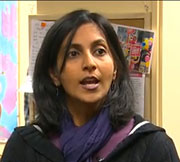FACULTY FOCUS
Project Change at CSM: First program in county to bridge gap from incarceration to higher education
By Katie Bliss, CSM English Professor
 Sitting atop Tower Road off 92 in San Mateo is a newly renovated large and modern building, which operates as the county’s juvenile detention facility, and has for over 50 years; just five miles down the street off of 92 atop Hillsdale Boulevard is the College of San Mateo, which has served the community to provide open access to higher education and has just recently celebrated its 50th anniversary. These two institutions have always been so close in proximity, but so seemingly separate in purpose and communication; however, over the last several years, attitudes about the best ways to help at-risk youth create change in their lives in a positive way has evolved from punishment to rehabilitation. For the first time in San Mateo County, there is an all inclusive bridge program that links these two facilities together to help young people make the transition from incarceration to higher education, and it is called Project Change.
Sitting atop Tower Road off 92 in San Mateo is a newly renovated large and modern building, which operates as the county’s juvenile detention facility, and has for over 50 years; just five miles down the street off of 92 atop Hillsdale Boulevard is the College of San Mateo, which has served the community to provide open access to higher education and has just recently celebrated its 50th anniversary. These two institutions have always been so close in proximity, but so seemingly separate in purpose and communication; however, over the last several years, attitudes about the best ways to help at-risk youth create change in their lives in a positive way has evolved from punishment to rehabilitation. For the first time in San Mateo County, there is an all inclusive bridge program that links these two facilities together to help young people make the transition from incarceration to higher education, and it is called Project Change.
For many years, students have been able to acquire high school credit or receive their GEDs while incarcerated; however, there hasn’t been anything formally in place for students to begin their work on a college degree, or a specific support network for them when they start attending college. In this difficult economic climate where a postsecondary degree or credential is imperative for job opportunities, it is invaluable that all youth have access to quality higher education. Furthermore, when youth are involved with the criminal justice system, it can heighten the magnitude of disconnect from education, which results in devastating effects on the attainment of a career, economic success, emotional well-being, and a positive sense of self. There has been a strong need for programs that provide opportunities for young people when they are released back into the community. Career training and high school level education has been the primary focus, and now the next building block for opportunity and change is higher education.
The College of San Mateo’s Project Change is an all-inclusive, collaborative bridge program that provides the resources of academic and emotional support to help students make the successful transition from juvenile hall to community college. The program was approved by the Basic Skills Initiative in November 2013 and is currently in the development period. The pilot is set to begin this summer in June 2014. Project Change collaborates with Gateway Community School, the nonprofit Each One Reach One, the juvenile hall Youth Services Center, with services campus wide at the College of San Mateo, and with faculty and staff from across the disciplines to provide an inclusive and streamlined transitional program.
Designed to provide extensive student support
The design of the program includes:
• Providing Academic and Peer Mentors: students are matched with both peer and faculty mentors from across the disciplines for the full academic year. This is a relationship-based approach grounded in youth development to provide young people with a stable adult presence and a stable model of positive peers.
• Developing Academic Identity: students begin the program over the summer in a two-week class that focuses on English and math (Pathway to Success). The students from Project Change are intermingled with other students who are attending CSM from a variety of backgrounds. The students take the classes together as a cohort and receive more personalized academic attention, the opportunity for pre-registration, placement tests, and academic counseling for the upcoming semester. This increases their access to resources, social networks, assets, and opportunities.
• Support for Academic and College Readiness: workshops both inside juvenile hall and on the CSM campus are provided to students to help facilitate closing the gaps in academic knowledge and promote development of skills needed for college success, such as time management and study skills. These workshops help foster an interest and awareness of the possibility of college as an option for their future.
• Student Support Services: students are provided services for which they are eligible, which can include EOPS, CARE, services from the disability center, psychological counseling, the multi-cultural center, and career and academic counseling.
• College Wide Collaboration and Culture: multiple programs including Student Support Services, the Learning Center, Psychological Services, Counseling, and faculty and staff from across the disciplines are working together to communicate and provide a more streamlined approach to assisting the incoming students in Project Change with their success as college students.
• Alliance and Collaboration with Youth Services Center (formally Hillcrest Juvenile Hall) and Gateway Community School: Staff, probation, attorneys, judges, teachers, and administrators are working in collaboration to foster a successful and supportive transition from the juvenile hall to community college.
Program developed from personal experience
The challenges a student can face when trying to make the transition from incarceration to higher education can be daunting. Navigating the college experience can be an overwhelming task and this program aims to help make this move more accessible. Having myself been a teenager who was incarcerated in San Mateo County’s juvenile hall for the majority of my junior year and senior year of high school, and prior to that attending continuation school, I understand the obstacles that one can face when trying to enroll in college for the first time. It has been a goal for many years to set up a program that could address these difficulties and make the transition to college more accessible for incarcerated youth.
While incarcerated, I was able to work on my many missing high school credits, and I was able to finish my high school degree while in the juvenile hall. When I was released, I was at a crossroads and unsure of what direction my life was to take. I had what equated to an 8th grade formal education at the time, having not been in traditional school for the last four years. Certainly no one expected me to go to college, so I got a part-time job at 18 at a bookstore; one thing in my favor was my love of reading. One afternoon, someone came by the bookstore and dropped off a stack of College of San Mateo catalogs. I decided to browse through them, and I noticed that there was a certificate program in counseling people with drug and alcohol addiction. It piqued my interest and I decided to enroll for the spring.
I was truly frightened when I got off the bus and stepped foot on campus that first day. I had no academic skills, and no concept of myself as a student. However, the professors who I had in the Alcohol and Other Drug Certificate Program, in my psychology, math, philosophy, and English classes, all were such dedicated and enthusiastic teachers; their energy inspired in me a love of learning, and they took the time to help me during their office hours when I was struggling with the material, how to figure out time management, or how to more strategically study instead of highlighting everything in my textbooks. A few of them truly became mentors to me during the three years I was at CSM before transferring. Navigating the system of higher education was challenging, and figuring out all of my financial aid was a constant battle, but people in Student Support Services always provided me with guidance. I learned slowly how to become a successful student. This was a huge leap, from having left high school my sophomore year with a 0.2 GPA to getting my first A’s in a decade in my psychology and English classes. I was also meeting other students who were focused on school and who could show me how to be a student, and we started studying together. Eventually, I had created a network of both faculty and peer academic support. I was beginning to see that this was an actual possibility for me; I could become a college student.
I transferred in my third year and went on to get a bachelors and a master’s degree (the first in my family to do so), and returned to teach at the College of San Mateo where I’ve had the great privilege to work alongside many of the professors who inspired me to pursue my education.
The design of Project Change centers around many of those factors that contributed to my transition from incarceration to higher education: faculty and peer mentors, Student Support Services, encouraging student leadership, and fostering a sense of academic identity. There is a need for students to have support when they make this change, and Project Change provides this in a structured and supported package.
The enthusiasm that has been displayed by everyone from the college faculty, staff, students, administrators, and Basic Skills committee at the College of San Mateo, to Gateway Community School and Youth Services Center has been tremendous. There is an abundance of energy and care for helping these young people be successful, make a positive change, and have opportunities for the future.
For further information, updates, and ways that you can get involved in Project Change, please check out our website (collegeofsanmateo.edu/projectchange/) and “like” us on Facebook to keep informed.


